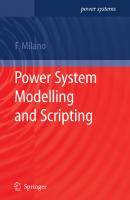Predictive Modelling for Energy Management and Power Systems Engineering 9780128177723, 0128177721
Predictive Modeling for Energy Management and Power Systems Engineering introduces readers to the cutting-edge use of bi
285 58 47MB
English Pages 552 [546] Year 2020
Table of contents :
Title-pag_2021_Predictive-Modelling-for-Energy-Management-and-Power-Systems-
Predictive Modelling for Energy Management and Power Systems Engineering
Copyrigh_2021_Predictive-Modelling-for-Energy-Management-and-Power-Systems-E
Copyright
Content_2021_Predictive-Modelling-for-Energy-Management-and-Power-Systems-En
Contents
List-of-Contribu_2021_Predictive-Modelling-for-Energy-Management-and-Power-S
List of Contributors
About-the-edit_2021_Predictive-Modelling-for-Energy-Management-and-Power-Sys
About the editors
Forewor_2021_Predictive-Modelling-for-Energy-Management-and-Power-Systems-En
Foreword
Preface_2021_Predictive-Modelling-for-Energy-Management-and-Power-Systems-En
Preface
What problem does this book solve?
Why would readers choose this book?
Rigor
Chapter-1---A-Multiobjective-optimal-VAR-disp_2021_Predictive-Modelling-for-
1 A Multiobjective optimal VAR dispatch using FACTS devices considering voltage stability and contingency analysis
1.1 Introduction
1.2 Problem formulation
1.2.1 Objectives functions
1.2.1.1 Minimizing the investment cost of SVC and TCSC devices
1.2.1.2 Minimizing the transmission real power losses
1.2.1.3 Minimizing the voltage stability
1.2.2 Equality and inequality constraints
1.2.2.1 Equality constraints (the load flow equations)
1.2.2.2 Inequality constraints (technical limitations)
1.3 A proposed hybrid particle swarm optimization and gravitational search algorithm
1.3.1 Particle swarm optimization
1.3.2 Gravitational search algorithm
1.3.3 A hybrid particle swarm optimization gravitational search algorithm
1.4 Stability index
1.4.1 Fast voltage stability index
1.4.2 Lmn
1.5 Flexible alternating current transmission systems modeling
1.5.1 Thyristor controlled series compensator model
1.5.2 Static volt ampere reactive compensator model
1.6 Simulation results
1.6.1 Description of the test system and simulation results
1.7 Conclusion
References
Appendix
Chapter-2---Photovoltaic-panels-l_2021_Predictive-Modelling-for-Energy-Manag
2 Photovoltaic panels life span increase by control
Acronyms
Chapter outcome
2.1 Introduction
2.2 Degradation modes of photovoltaic panels
2.2.1 Introduction
2.2.2 Potential-induced degradation
2.2.2.1 Potential-induced degradation causes
2.2.2.2 Potential-induced degradation modeling
2.2.3 Light-induced degradation
2.2.3.1 Light-induced degradation in c-Si cells
2.2.3.2 Light-induced degradation in a-Si:H cells
2.2.3.3 Light-induced degradation modeling
2.2.4 Ultraviolet light degradation
2.2.4.1 Ultraviolet light degradation causes
2.2.4.2 Ultraviolet light degradation modeling
2.2.5 Moisture-induced degradation
2.2.5.1 Moisture-induced degradation causes
2.2.5.2 Moisture-induced degradation modeling
2.3 Real-time simulation model
2.3.1 Development of the model
2.3.2 Simulation results
2.3.2.1 Irradiance variation
2.3.2.2 Temperature variation
2.3.3 Validation of the model
2.4 Thermal model of a photovoltaic panel
2.4.1 Thermal model development
2.4.2 Model exploration
2.4.2.1 Model development
2.4.2.2 Simulation and result extraction
2.4.3 Experimental validation
2.4.3.1 Experimental apparatus
2.4.3.2 Experimental result
2.5 Mitigation of degradation via control
2.5.1 Real-time simulation model with thermal behavior
2.5.2 Maximum life span point
2.5.3 Tracking the maximum life span point
2.5.3.1 Applying maximum power point tracking techniques to track the maximum life span point
2.5.4 Results
2.5.5 Discussion
2.6 Conclusion
References
Chapter-3---Community-scale-rural-energy-sy_2021_Predictive-Modelling-for-En
3 Community-scale rural energy systems: General planning algorithms and methods for developing countries
List of Acronyms
3.1 Introduction
3.1.1 Theoretical framework
3.1.2 Methodology
3.1.2.1 Resource assessment
3.1.2.2 Load surveys
3.1.2.3 Terrain recognition
3.1.3 The generation cost curves
3.1.3.1 Centralized generation cost curves
3.1.3.2 Isolated generation cost curves
3.1.3.3 Simulation results: centralized grid and isolated systems
3.1.4 Case Study
3.1.5 Results and discussion
3.1.5.1 Resource assessment, load surveys, and terrain recognition
3.1.5.2 The generation cost curves
3.1.5.3 Simulation results: centralized grid and isolated
3.1.5.4 General discussion
3.2 Conclusion
References
Chapter-4---Proven-energy-storage-system-a_2021_Predictive-Modelling-for-Ene
4 Proven energy storage system applications for power systems stability and transition issues
4.1 Introduction
4.2 Proven energy storage for increased service provision
4.3 Grid functions for energy storage system
4.4 Energy storage characterization for digital inertia
4.4.1 Size analysis of energy storage
4.4.2 Hybridized energy storage systems
4.4.3 Increased service provision to transmission systems operator
4.5 Test model of the transmission system
4.5.1 Embedded generation
4.5.2 BESS operation
4.5.3 Droop response and deadband for frequency quality
4.5.4 PV control
4.5.5 Charge control
4.5.6 Ultracapacitor storage
4.5.7 Case studies
4.6 Future implications of hybridized scheme to transition issues
4.6.1 Dynamic system stability
4.6.2 Impact of HESS responses
4.7 Chapter summary
References
Chapter-5---Design-and-performance-of-two-decomposit_2021_Predictive-Modelli
5 Design and performance of two decomposition paradigms in forecasting daily solar radiation with evolutionary polynomial r...
5.1 Introduction
5.2 Study area and evaluation criterion
5.3 Methodology
5.3.1 Wavelet transform
5.3.2 Ensemble empirical mode decomposition
5.3.3 Evolutionary polynomial regression
5.4 Models implementation and application
5.4.1 Wavelet transform-based DSR forecasting
5.4.2 Ensemble empirical mode decomposition-based DSR forecasting
5.5 Results and discussions
5.5.1 Performance comparison of the developed hybrid models at Busan station
5.5.2 Performance comparison of the developed hybrid models at Seoul station
5.5.3 Monte Carlo simulation-uncertainty analysis
5.6 Conclusions
Appendix
References
Chapter-6---Development-of-data-driven_2021_Predictive-Modelling-for-Energy-
6 Development of data-driven models for wind speed forecasting in Australia
6.1 Introduction
6.1.1 ANN model
6.1.2 MLR model
6.1.3 RF model
6.1.4 M5 tree model
6.1.5 ARIMA model
6.2 Materials and methods
6.2.1 Data sources
6.2.1.1 Characteristics of short-term wind data
6.2.1.2 Characteristics of daily wind data
6.2.2 ANN model
6.2.3 MLR model
6.2.4 RF model
6.2.5 M5 tree model
6.2.6 ARIMA model
6.2.7 Performance evaluation
6.2.7.1 Correlation coefficient
6.2.7.2 Nash–Sutcliffe coefficient
6.2.7.3 Willmott’s index of agreement
6.2.7.4 Root mean square error
6.2.7.5 Mean absolute error
6.2.7.6 Relative root mean square error
6.2.7.7 Relative mean absolute error
6.2.7.8 Legates and McCabes index
6.3 Results of short-term wind speed forecasting
6.3.1 Selection of net winds
6.3.2 Model design for short-term prediction
6.3.3 Model performance
6.3.3.1 ANN model performance for short-term time series
6.3.3.2 RF model performance for short-term time series
6.3.3.3 M5 tree model performance for short-term time series
6.3.3.4 MLR model performance for short-term time series
6.3.4 Model comparison for short-term wind speed prediction
6.3.4.1 Comparison of different models for U wind
6.3.4.2 Comparison of different models for V wind
6.3.4.3 Comparison of different models for N wind
6.4 Results of daily wind speed forecasting
6.4.1 Model design for daily wind speed prediction
6.4.2 Model performance
6.4.2.1 ANN model performance for daily time series
6.4.2.2 RF model performance for daily time series
6.4.2.3 M5 tree model performance for daily time series
6.4.2.4 MLR model performance for daily time series
6.4.3 Model comparison for daily wind speed prediction
6.4.3.1 Comparison of different models for U wind forecasting for daily time scale
6.4.3.2 Comparison of different models for V wind forecasting for daily time scale
6.4.3.3 Comparison of different models for N wind forecasting for daily time scale
6.5 Summary
6.5.1 Concluding remark
6.5.2 Summary of the findings
6.5.2.1 Summary of findings of short-term (6-hourly) wind speed prediction
6.5.2.2 Summary of findings of daily wind speed prediction
6.5.3 Limitations and recommendations for future works
References
Chapter-7---Hybrid-multilayer-perceptron-firefly_2021_Predictive-Modelling-f
7 Hybrid multilayer perceptron-firefly optimizer algorithm for modelling photosynthetic active solar radiation for biofuel ...
Acronyms
7.1 Introduction
7.2 Chapter background review
7.2.1 Statistical and mathematical models
7.2.2 Artificial intelligence models
7.2.3 Other par estimation methods
7.2.4 Concluding remarks
7.3 Materials and methodology
7.3.1 Study region and data
7.3.2 Model description
7.3.2.1 Normalization, feature selection, and data partitions
Normalization
Feature selection
Train, test, and validation data partitions
7.3.2.2 Multilayer perceptron neural network
7.3.2.3 Hybrid multilayer perceptron-Firefly algorithm model
7.3.2.4 Random forest model
7.3.2.5 Multiple linear regression model
7.3.2.6 Justification of choice of models
7.3.3 Performance evaluation
7.3.4 Methodology overview
7.4 Application results and analysis
7.4.1 Development of predictive models
7.4.1.1 Feature selection
7.4.1.2 Multilayer perceptron-firefly algorithm and multilayer perceptron
Train, test, and validation splits
Hidden layer size
Transfer function
Training algorithm
7.4.1.3 Comparative baseline models – random forest and multiple linear regression
7.4.2 Model comparisons
7.5 Discussion
7.6 Conclusion
References
Further reading
Chapter-8---Predictive-modeling-of-oscill_2021_Predictive-Modelling-for-Ener
8 Predictive modeling of oscillating plasma energy release for clean combustion engines
8.1 Introduction
8.2 Challenges of plasma discharge under engine conditions
8.2.1 Ignition system impact
8.2.2 Background condition impact
8.2.3 External disturbance impact
8.3 Experimental setup and methodology
8.3.1 High-frequency plasma power drive
8.3.2 Mathematical description and model assumption of the plasma ignition system
8.3.3 Experimental instruments
8.4 Predictive modeling of oscillating plasma discharge
8.4.1 Measurement of electrical waveforms
8.4.2 Oscillating frequency modulation
8.4.3 Plasma discharge patterns and external effects
8.4.4 Predictive modeling of oscillating plasma impedance
8.4.5 Predictive modeling of oscillating plasma discharge energy
8.5 Conclusions
References
Chapter-9---Nowcasting-solar-irradiance-fo_2021_Predictive-Modelling-for-Ene
9 Nowcasting solar irradiance for effective solar power plants operation and smart grid management
9.1 Introduction
9.2 Solar irradiance
9.2.1 Solar irradiance—terms and definition
9.2.2 Radiometric data used in this study
9.2.3 Postprocessed data
9.2.4 Solar irradiance variability
9.2.5 Data series used in this study
9.3 Statistical models for short-time solar irradiance
9.3.1 Persistence
9.3.2 ARIMA modeling of clearness index
9.3.3 The two-state model
9.3.4 Accuracy metrics
9.4 Performance of the solar irradiance forecast
9.4.1 Time horizon
9.4.2 Precision
9.4.3 Stability of the solar radiative regime
9.5 Conclusions
References
Chapter-10---Short-term-electrical-energy-demand_2021_Predictive-Modelling-f
10 Short-term electrical energy demand prediction under heat island effects using emotional neural network integrated with ...
10.1 Introduction
10.2 Theoretical overview
10.2.1 Hybrid winner-take-all emotional neural network
10.2.2 Random forest model
10.2.3 Multiple linear regression
10.3 Study area and data
10.3.1 Study area
10.3.2 Data
10.3.2.1 Input variable selection
10.3.2.2 Temporal and spatial resolution
10.3.2.3 Electricity demand data
10.4 Predictive model development
10.4.1 Feature engineering
10.4.2 Normalization
10.4.3 Significant lags
10.4.4 Testing and training sets
10.4.5 Winner-take-all emotional neural network model mevelopment
10.4.6 Random forest model development
10.4.7 Multiple linear regression model
10.4.8 Model performance assessment
10.5 Results and discussion
10.5.1 Demand predictions utilizing air temperature data from fixed weather stations
10.5.2 Demand predictions utilizing air temperature data from reanalysis
10.6 Conclusions and remarks
10.7 Limitations and further research
References
Chapter-11---Artificial-neural-networks-and-a_2021_Predictive-Modelling-for-
11 Artificial neural networks and adaptive neuro-fuzzy inference system in energy modeling of agricultural products
11.1 Introduction
11.2 Data collection and energy calculation
11.2.1 Data collection
11.2.1.1 Sample size method
11.2.1.2 The design of the questionnaire
11.2.1.2.1 Reliability of the questionnaire
11.2.1.2.2 Validity of questionnaire
11.2.1.3 Datasets
11.2.2 Energy analysis
11.2.2.1 Input–output energy
11.2.3 Energy indices
11.3 Artificial neural network
11.3.1 Multilayer perception structure
11.3.2 Feedforward neural network
11.3.3 Backpropagation neural network
11.3.4 Levenberg–Marquardt learning algorithm
11.3.5 Overfitting
11.3.6 Sensitivity analysis
11.4 Adaptive neuro-fuzzy inference system
11.4.1 Fuzzy inference system
11.4.2 Adaptive network
11.4.3 Adaptive neuro-fuzzy inference system architecture
11.5 Validation of artificial neural network and adaptive neuro-fuzzy inference system model
11.6 Other models of machine learning
11.6.1 Support vector machine
11.6.2 Bayesian network
11.6.3 Genetic algorithm
11.7 Interpretation of results
11.7.1 Estimation of energy consumption
11.7.2 Artificial neural network model results
11.7.2.1 Sensitivity analysis results
11.7.3 Adaptive neuro-fuzzy inference system simulation results
11.7.4 Adaptive neuro-fuzzy inference system simulation results
11.8 Conclusion
References
Chapter-12---Support-vector-machine-m_2021_Predictive-Modelling-for-Energy-M
12 Support vector machine model for multistep wind speed forecasting
12.1 Introduction
12.2 Literature review
12.2.1 Physical methods
12.2.2 Statistical methods
12.2.3 Data-driven methods
12.2.4 Hybrid methods
12.3 Materials and method
12.3.1 Theoretical background
12.3.1.1 Support vector machine model
12.3.1.2 Second-order Volterra model
12.3.1.3 Autoregressive integrated moving average model
12.3.1.4 Complete ensemble empirical mode decomposition with adaptive noise
12.3.2 Study area and data
12.3.2.1 Study area
12.3.2.2 Data
12.3.3 Predictive model development
12.3.4 Model performance evaluation criteria
12.4 Results and discussion
12.4.1 Short-term wind speed forecasting
12.4.2 Medium-term wind speed forecasting
12.4.3 Long-term wind speed forecasting
12.5 Conclusion
References
Appendix
Chapter-13---MARS-model-for-prediction_2021_Predictive-Modelling-for-Energy-
13 MARS model for prediction of short- and long-term global solar radiation
13.1 Introduction
13.2 Literature review
13.2.1 The advantages of machine learning models
13.2.2 Studies on machine learning methods used as a universal model
13.2.3 Studies on machine learning methods used in solar radiation forecasting
13.2.4 General applications of mars model used in previous research
13.2.5 MARS model applications in solar radiation forecasting
13.3 Materials and methodology
13.3.1 Study area
13.3.2 Data
13.3.3 Methodology
13.3.3.1 Theory of MARS model
13.3.3.2 Theory of the autoregressive integrated moving average model
13.3.3.3 The model development
13.3.3.4 Model evaluation criteria
13.4 Results and discussion
13.4.1 MARS model for short-term forecasting
13.4.1.1 Model development
13.4.1.2 Estimation of daily solar radiation in regional Queensland
13.4.1.3 Forecasting daily solar radiation in regional Queensland
13.4.2 MARS model for long-term solar radiation forecasting and seasonal analysis
13.4.2.1 Model development
13.4.2.2 Estimation of monthly solar radiation in regional Queensland
13.4.2.3 Forecasting monthly solar radiation in regional Queensland
13.4.2.4 Seasonal analysis for the four target sites
13.5 Conclusion
References
Chapter-14---Wind-speed-forecasting-in-Nepal_2021_Predictive-Modelling-for-E
14 Wind speed forecasting in Nepal using self-organizing map-based online sequential extreme learning machine
14.1 Introduction
14.1.1 Research objectives
14.2 Literature review
14.2.1 Wind speed forecasting and forecast horizon
14.2.2 Data partitioning in forecasting
14.2.3 Wind forecasting models
14.2.4 Extreme learning machine
14.2.5 Online sequential extreme learning machine
14.3 Materials and methods
14.3.1 Study area and dataset
14.3.2 Theoretical details of models
14.3.2.1 Data splitting method: self-organizing map
14.3.2.2 Objective model: online sequential extreme learning machine
14.3.2.3 Benchmark method: M5
14.3.2.4 Benchmark method: autoregressive integrated moving average model
14.3.2.5 Model development
14.3.2.6 Model evaluation methods
14.3.2.6.1 Correlation coefficient (r)
14.3.2.6.2 Root mean square error
14.3.2.6.3 Mean absolute error
14.3.2.6.4 Mean absolute percentage error
14.3.2.6.5 Relative root mean squared error
14.3.2.6.6 Nash–Sutcliffe model of efficiency coefficient
14.3.2.6.7 Willmott index
14.3.2.6.8 Legates and McCabe’s index
14.4 Short-term forecasting
14.4.1 Dataset for short-term forecasting
14.4.2 Model development of short-term forecasting
14.4.3 Results for short-term forecasting
14.4.4 Summary for short-term forecasting
14.5 Daily forecasting model
14.5.1 Dataset for daily forecasting
14.5.2 Model development for daily forecasting
14.5.3 Results for daily forecasting
14.5.4 Summary for daily forecasting
14.6 Monthly forecasting model
14.6.1 Dataset for monthly forecasting
14.6.2 Model development for monthly forecasting
14.6.3 Results for monthly forecasting
14.6.4 Summary for monthly forecasting
14.7 Conclusion
References
Chapter-15---Potential-growth-in-small-sc_2021_Predictive-Modelling-for-Ener
15 Potential growth in small-scale distributed generation systems in Brazilian capitals
15.1 Introduction
15.2 Distributed generation in Brazil
15.3 Measurement method
15.4 Results
15.5 Conclusion
References
Chapter-16---Trend-of-energy-consumption-in-de_2021_Predictive-Modelling-for
16 Trend of energy consumption in developing nations in the last two decades: a case study from a statistical perspective
16.1 Introduction
16.2 Related work
16.3 Implementation
16.3.1 Data sources
16.3.2 Data exploration
16.3.3 Analysis on Developing countries
16.3.4 Prediction using proposed models
16.3.5 Findings and output
16.4 Conclusion
References
Index_2021_Predictive-Modelling-for-Energy-Management-and-Power-Systems-Engi
Index
Title-pag_2021_Predictive-Modelling-for-Energy-Management-and-Power-Systems-
Predictive Modelling for Energy Management and Power Systems Engineering
Copyrigh_2021_Predictive-Modelling-for-Energy-Management-and-Power-Systems-E
Copyright
Content_2021_Predictive-Modelling-for-Energy-Management-and-Power-Systems-En
Contents
List-of-Contribu_2021_Predictive-Modelling-for-Energy-Management-and-Power-S
List of Contributors
About-the-edit_2021_Predictive-Modelling-for-Energy-Management-and-Power-Sys
About the editors
Forewor_2021_Predictive-Modelling-for-Energy-Management-and-Power-Systems-En
Foreword
Preface_2021_Predictive-Modelling-for-Energy-Management-and-Power-Systems-En
Preface
What problem does this book solve?
Why would readers choose this book?
Rigor
Chapter-1---A-Multiobjective-optimal-VAR-disp_2021_Predictive-Modelling-for-
1 A Multiobjective optimal VAR dispatch using FACTS devices considering voltage stability and contingency analysis
1.1 Introduction
1.2 Problem formulation
1.2.1 Objectives functions
1.2.1.1 Minimizing the investment cost of SVC and TCSC devices
1.2.1.2 Minimizing the transmission real power losses
1.2.1.3 Minimizing the voltage stability
1.2.2 Equality and inequality constraints
1.2.2.1 Equality constraints (the load flow equations)
1.2.2.2 Inequality constraints (technical limitations)
1.3 A proposed hybrid particle swarm optimization and gravitational search algorithm
1.3.1 Particle swarm optimization
1.3.2 Gravitational search algorithm
1.3.3 A hybrid particle swarm optimization gravitational search algorithm
1.4 Stability index
1.4.1 Fast voltage stability index
1.4.2 Lmn
1.5 Flexible alternating current transmission systems modeling
1.5.1 Thyristor controlled series compensator model
1.5.2 Static volt ampere reactive compensator model
1.6 Simulation results
1.6.1 Description of the test system and simulation results
1.7 Conclusion
References
Appendix
Chapter-2---Photovoltaic-panels-l_2021_Predictive-Modelling-for-Energy-Manag
2 Photovoltaic panels life span increase by control
Acronyms
Chapter outcome
2.1 Introduction
2.2 Degradation modes of photovoltaic panels
2.2.1 Introduction
2.2.2 Potential-induced degradation
2.2.2.1 Potential-induced degradation causes
2.2.2.2 Potential-induced degradation modeling
2.2.3 Light-induced degradation
2.2.3.1 Light-induced degradation in c-Si cells
2.2.3.2 Light-induced degradation in a-Si:H cells
2.2.3.3 Light-induced degradation modeling
2.2.4 Ultraviolet light degradation
2.2.4.1 Ultraviolet light degradation causes
2.2.4.2 Ultraviolet light degradation modeling
2.2.5 Moisture-induced degradation
2.2.5.1 Moisture-induced degradation causes
2.2.5.2 Moisture-induced degradation modeling
2.3 Real-time simulation model
2.3.1 Development of the model
2.3.2 Simulation results
2.3.2.1 Irradiance variation
2.3.2.2 Temperature variation
2.3.3 Validation of the model
2.4 Thermal model of a photovoltaic panel
2.4.1 Thermal model development
2.4.2 Model exploration
2.4.2.1 Model development
2.4.2.2 Simulation and result extraction
2.4.3 Experimental validation
2.4.3.1 Experimental apparatus
2.4.3.2 Experimental result
2.5 Mitigation of degradation via control
2.5.1 Real-time simulation model with thermal behavior
2.5.2 Maximum life span point
2.5.3 Tracking the maximum life span point
2.5.3.1 Applying maximum power point tracking techniques to track the maximum life span point
2.5.4 Results
2.5.5 Discussion
2.6 Conclusion
References
Chapter-3---Community-scale-rural-energy-sy_2021_Predictive-Modelling-for-En
3 Community-scale rural energy systems: General planning algorithms and methods for developing countries
List of Acronyms
3.1 Introduction
3.1.1 Theoretical framework
3.1.2 Methodology
3.1.2.1 Resource assessment
3.1.2.2 Load surveys
3.1.2.3 Terrain recognition
3.1.3 The generation cost curves
3.1.3.1 Centralized generation cost curves
3.1.3.2 Isolated generation cost curves
3.1.3.3 Simulation results: centralized grid and isolated systems
3.1.4 Case Study
3.1.5 Results and discussion
3.1.5.1 Resource assessment, load surveys, and terrain recognition
3.1.5.2 The generation cost curves
3.1.5.3 Simulation results: centralized grid and isolated
3.1.5.4 General discussion
3.2 Conclusion
References
Chapter-4---Proven-energy-storage-system-a_2021_Predictive-Modelling-for-Ene
4 Proven energy storage system applications for power systems stability and transition issues
4.1 Introduction
4.2 Proven energy storage for increased service provision
4.3 Grid functions for energy storage system
4.4 Energy storage characterization for digital inertia
4.4.1 Size analysis of energy storage
4.4.2 Hybridized energy storage systems
4.4.3 Increased service provision to transmission systems operator
4.5 Test model of the transmission system
4.5.1 Embedded generation
4.5.2 BESS operation
4.5.3 Droop response and deadband for frequency quality
4.5.4 PV control
4.5.5 Charge control
4.5.6 Ultracapacitor storage
4.5.7 Case studies
4.6 Future implications of hybridized scheme to transition issues
4.6.1 Dynamic system stability
4.6.2 Impact of HESS responses
4.7 Chapter summary
References
Chapter-5---Design-and-performance-of-two-decomposit_2021_Predictive-Modelli
5 Design and performance of two decomposition paradigms in forecasting daily solar radiation with evolutionary polynomial r...
5.1 Introduction
5.2 Study area and evaluation criterion
5.3 Methodology
5.3.1 Wavelet transform
5.3.2 Ensemble empirical mode decomposition
5.3.3 Evolutionary polynomial regression
5.4 Models implementation and application
5.4.1 Wavelet transform-based DSR forecasting
5.4.2 Ensemble empirical mode decomposition-based DSR forecasting
5.5 Results and discussions
5.5.1 Performance comparison of the developed hybrid models at Busan station
5.5.2 Performance comparison of the developed hybrid models at Seoul station
5.5.3 Monte Carlo simulation-uncertainty analysis
5.6 Conclusions
Appendix
References
Chapter-6---Development-of-data-driven_2021_Predictive-Modelling-for-Energy-
6 Development of data-driven models for wind speed forecasting in Australia
6.1 Introduction
6.1.1 ANN model
6.1.2 MLR model
6.1.3 RF model
6.1.4 M5 tree model
6.1.5 ARIMA model
6.2 Materials and methods
6.2.1 Data sources
6.2.1.1 Characteristics of short-term wind data
6.2.1.2 Characteristics of daily wind data
6.2.2 ANN model
6.2.3 MLR model
6.2.4 RF model
6.2.5 M5 tree model
6.2.6 ARIMA model
6.2.7 Performance evaluation
6.2.7.1 Correlation coefficient
6.2.7.2 Nash–Sutcliffe coefficient
6.2.7.3 Willmott’s index of agreement
6.2.7.4 Root mean square error
6.2.7.5 Mean absolute error
6.2.7.6 Relative root mean square error
6.2.7.7 Relative mean absolute error
6.2.7.8 Legates and McCabes index
6.3 Results of short-term wind speed forecasting
6.3.1 Selection of net winds
6.3.2 Model design for short-term prediction
6.3.3 Model performance
6.3.3.1 ANN model performance for short-term time series
6.3.3.2 RF model performance for short-term time series
6.3.3.3 M5 tree model performance for short-term time series
6.3.3.4 MLR model performance for short-term time series
6.3.4 Model comparison for short-term wind speed prediction
6.3.4.1 Comparison of different models for U wind
6.3.4.2 Comparison of different models for V wind
6.3.4.3 Comparison of different models for N wind
6.4 Results of daily wind speed forecasting
6.4.1 Model design for daily wind speed prediction
6.4.2 Model performance
6.4.2.1 ANN model performance for daily time series
6.4.2.2 RF model performance for daily time series
6.4.2.3 M5 tree model performance for daily time series
6.4.2.4 MLR model performance for daily time series
6.4.3 Model comparison for daily wind speed prediction
6.4.3.1 Comparison of different models for U wind forecasting for daily time scale
6.4.3.2 Comparison of different models for V wind forecasting for daily time scale
6.4.3.3 Comparison of different models for N wind forecasting for daily time scale
6.5 Summary
6.5.1 Concluding remark
6.5.2 Summary of the findings
6.5.2.1 Summary of findings of short-term (6-hourly) wind speed prediction
6.5.2.2 Summary of findings of daily wind speed prediction
6.5.3 Limitations and recommendations for future works
References
Chapter-7---Hybrid-multilayer-perceptron-firefly_2021_Predictive-Modelling-f
7 Hybrid multilayer perceptron-firefly optimizer algorithm for modelling photosynthetic active solar radiation for biofuel ...
Acronyms
7.1 Introduction
7.2 Chapter background review
7.2.1 Statistical and mathematical models
7.2.2 Artificial intelligence models
7.2.3 Other par estimation methods
7.2.4 Concluding remarks
7.3 Materials and methodology
7.3.1 Study region and data
7.3.2 Model description
7.3.2.1 Normalization, feature selection, and data partitions
Normalization
Feature selection
Train, test, and validation data partitions
7.3.2.2 Multilayer perceptron neural network
7.3.2.3 Hybrid multilayer perceptron-Firefly algorithm model
7.3.2.4 Random forest model
7.3.2.5 Multiple linear regression model
7.3.2.6 Justification of choice of models
7.3.3 Performance evaluation
7.3.4 Methodology overview
7.4 Application results and analysis
7.4.1 Development of predictive models
7.4.1.1 Feature selection
7.4.1.2 Multilayer perceptron-firefly algorithm and multilayer perceptron
Train, test, and validation splits
Hidden layer size
Transfer function
Training algorithm
7.4.1.3 Comparative baseline models – random forest and multiple linear regression
7.4.2 Model comparisons
7.5 Discussion
7.6 Conclusion
References
Further reading
Chapter-8---Predictive-modeling-of-oscill_2021_Predictive-Modelling-for-Ener
8 Predictive modeling of oscillating plasma energy release for clean combustion engines
8.1 Introduction
8.2 Challenges of plasma discharge under engine conditions
8.2.1 Ignition system impact
8.2.2 Background condition impact
8.2.3 External disturbance impact
8.3 Experimental setup and methodology
8.3.1 High-frequency plasma power drive
8.3.2 Mathematical description and model assumption of the plasma ignition system
8.3.3 Experimental instruments
8.4 Predictive modeling of oscillating plasma discharge
8.4.1 Measurement of electrical waveforms
8.4.2 Oscillating frequency modulation
8.4.3 Plasma discharge patterns and external effects
8.4.4 Predictive modeling of oscillating plasma impedance
8.4.5 Predictive modeling of oscillating plasma discharge energy
8.5 Conclusions
References
Chapter-9---Nowcasting-solar-irradiance-fo_2021_Predictive-Modelling-for-Ene
9 Nowcasting solar irradiance for effective solar power plants operation and smart grid management
9.1 Introduction
9.2 Solar irradiance
9.2.1 Solar irradiance—terms and definition
9.2.2 Radiometric data used in this study
9.2.3 Postprocessed data
9.2.4 Solar irradiance variability
9.2.5 Data series used in this study
9.3 Statistical models for short-time solar irradiance
9.3.1 Persistence
9.3.2 ARIMA modeling of clearness index
9.3.3 The two-state model
9.3.4 Accuracy metrics
9.4 Performance of the solar irradiance forecast
9.4.1 Time horizon
9.4.2 Precision
9.4.3 Stability of the solar radiative regime
9.5 Conclusions
References
Chapter-10---Short-term-electrical-energy-demand_2021_Predictive-Modelling-f
10 Short-term electrical energy demand prediction under heat island effects using emotional neural network integrated with ...
10.1 Introduction
10.2 Theoretical overview
10.2.1 Hybrid winner-take-all emotional neural network
10.2.2 Random forest model
10.2.3 Multiple linear regression
10.3 Study area and data
10.3.1 Study area
10.3.2 Data
10.3.2.1 Input variable selection
10.3.2.2 Temporal and spatial resolution
10.3.2.3 Electricity demand data
10.4 Predictive model development
10.4.1 Feature engineering
10.4.2 Normalization
10.4.3 Significant lags
10.4.4 Testing and training sets
10.4.5 Winner-take-all emotional neural network model mevelopment
10.4.6 Random forest model development
10.4.7 Multiple linear regression model
10.4.8 Model performance assessment
10.5 Results and discussion
10.5.1 Demand predictions utilizing air temperature data from fixed weather stations
10.5.2 Demand predictions utilizing air temperature data from reanalysis
10.6 Conclusions and remarks
10.7 Limitations and further research
References
Chapter-11---Artificial-neural-networks-and-a_2021_Predictive-Modelling-for-
11 Artificial neural networks and adaptive neuro-fuzzy inference system in energy modeling of agricultural products
11.1 Introduction
11.2 Data collection and energy calculation
11.2.1 Data collection
11.2.1.1 Sample size method
11.2.1.2 The design of the questionnaire
11.2.1.2.1 Reliability of the questionnaire
11.2.1.2.2 Validity of questionnaire
11.2.1.3 Datasets
11.2.2 Energy analysis
11.2.2.1 Input–output energy
11.2.3 Energy indices
11.3 Artificial neural network
11.3.1 Multilayer perception structure
11.3.2 Feedforward neural network
11.3.3 Backpropagation neural network
11.3.4 Levenberg–Marquardt learning algorithm
11.3.5 Overfitting
11.3.6 Sensitivity analysis
11.4 Adaptive neuro-fuzzy inference system
11.4.1 Fuzzy inference system
11.4.2 Adaptive network
11.4.3 Adaptive neuro-fuzzy inference system architecture
11.5 Validation of artificial neural network and adaptive neuro-fuzzy inference system model
11.6 Other models of machine learning
11.6.1 Support vector machine
11.6.2 Bayesian network
11.6.3 Genetic algorithm
11.7 Interpretation of results
11.7.1 Estimation of energy consumption
11.7.2 Artificial neural network model results
11.7.2.1 Sensitivity analysis results
11.7.3 Adaptive neuro-fuzzy inference system simulation results
11.7.4 Adaptive neuro-fuzzy inference system simulation results
11.8 Conclusion
References
Chapter-12---Support-vector-machine-m_2021_Predictive-Modelling-for-Energy-M
12 Support vector machine model for multistep wind speed forecasting
12.1 Introduction
12.2 Literature review
12.2.1 Physical methods
12.2.2 Statistical methods
12.2.3 Data-driven methods
12.2.4 Hybrid methods
12.3 Materials and method
12.3.1 Theoretical background
12.3.1.1 Support vector machine model
12.3.1.2 Second-order Volterra model
12.3.1.3 Autoregressive integrated moving average model
12.3.1.4 Complete ensemble empirical mode decomposition with adaptive noise
12.3.2 Study area and data
12.3.2.1 Study area
12.3.2.2 Data
12.3.3 Predictive model development
12.3.4 Model performance evaluation criteria
12.4 Results and discussion
12.4.1 Short-term wind speed forecasting
12.4.2 Medium-term wind speed forecasting
12.4.3 Long-term wind speed forecasting
12.5 Conclusion
References
Appendix
Chapter-13---MARS-model-for-prediction_2021_Predictive-Modelling-for-Energy-
13 MARS model for prediction of short- and long-term global solar radiation
13.1 Introduction
13.2 Literature review
13.2.1 The advantages of machine learning models
13.2.2 Studies on machine learning methods used as a universal model
13.2.3 Studies on machine learning methods used in solar radiation forecasting
13.2.4 General applications of mars model used in previous research
13.2.5 MARS model applications in solar radiation forecasting
13.3 Materials and methodology
13.3.1 Study area
13.3.2 Data
13.3.3 Methodology
13.3.3.1 Theory of MARS model
13.3.3.2 Theory of the autoregressive integrated moving average model
13.3.3.3 The model development
13.3.3.4 Model evaluation criteria
13.4 Results and discussion
13.4.1 MARS model for short-term forecasting
13.4.1.1 Model development
13.4.1.2 Estimation of daily solar radiation in regional Queensland
13.4.1.3 Forecasting daily solar radiation in regional Queensland
13.4.2 MARS model for long-term solar radiation forecasting and seasonal analysis
13.4.2.1 Model development
13.4.2.2 Estimation of monthly solar radiation in regional Queensland
13.4.2.3 Forecasting monthly solar radiation in regional Queensland
13.4.2.4 Seasonal analysis for the four target sites
13.5 Conclusion
References
Chapter-14---Wind-speed-forecasting-in-Nepal_2021_Predictive-Modelling-for-E
14 Wind speed forecasting in Nepal using self-organizing map-based online sequential extreme learning machine
14.1 Introduction
14.1.1 Research objectives
14.2 Literature review
14.2.1 Wind speed forecasting and forecast horizon
14.2.2 Data partitioning in forecasting
14.2.3 Wind forecasting models
14.2.4 Extreme learning machine
14.2.5 Online sequential extreme learning machine
14.3 Materials and methods
14.3.1 Study area and dataset
14.3.2 Theoretical details of models
14.3.2.1 Data splitting method: self-organizing map
14.3.2.2 Objective model: online sequential extreme learning machine
14.3.2.3 Benchmark method: M5
14.3.2.4 Benchmark method: autoregressive integrated moving average model
14.3.2.5 Model development
14.3.2.6 Model evaluation methods
14.3.2.6.1 Correlation coefficient (r)
14.3.2.6.2 Root mean square error
14.3.2.6.3 Mean absolute error
14.3.2.6.4 Mean absolute percentage error
14.3.2.6.5 Relative root mean squared error
14.3.2.6.6 Nash–Sutcliffe model of efficiency coefficient
14.3.2.6.7 Willmott index
14.3.2.6.8 Legates and McCabe’s index
14.4 Short-term forecasting
14.4.1 Dataset for short-term forecasting
14.4.2 Model development of short-term forecasting
14.4.3 Results for short-term forecasting
14.4.4 Summary for short-term forecasting
14.5 Daily forecasting model
14.5.1 Dataset for daily forecasting
14.5.2 Model development for daily forecasting
14.5.3 Results for daily forecasting
14.5.4 Summary for daily forecasting
14.6 Monthly forecasting model
14.6.1 Dataset for monthly forecasting
14.6.2 Model development for monthly forecasting
14.6.3 Results for monthly forecasting
14.6.4 Summary for monthly forecasting
14.7 Conclusion
References
Chapter-15---Potential-growth-in-small-sc_2021_Predictive-Modelling-for-Ener
15 Potential growth in small-scale distributed generation systems in Brazilian capitals
15.1 Introduction
15.2 Distributed generation in Brazil
15.3 Measurement method
15.4 Results
15.5 Conclusion
References
Chapter-16---Trend-of-energy-consumption-in-de_2021_Predictive-Modelling-for
16 Trend of energy consumption in developing nations in the last two decades: a case study from a statistical perspective
16.1 Introduction
16.2 Related work
16.3 Implementation
16.3.1 Data sources
16.3.2 Data exploration
16.3.3 Analysis on Developing countries
16.3.4 Prediction using proposed models
16.3.5 Findings and output
16.4 Conclusion
References
Index_2021_Predictive-Modelling-for-Energy-Management-and-Power-Systems-Engi
Index

- Author / Uploaded
- Ravinesh Deo
- Pijush Samui
- Sanjiban Sekhar Roy
![Predictive Modelling for Energy Management and Power Systems Engineering [1 ed.]
0128177721, 9780128177723](https://ebin.pub/img/200x200/predictive-modelling-for-energy-management-and-power-systems-engineering-1nbsped-0128177721-9780128177723.jpg)








![Power Electronic Converters and Systems: Converters and machine drives (Energy Engineering) [2 ed.]
1839537671, 9781839537677](https://ebin.pub/img/200x200/power-electronic-converters-and-systems-converters-and-machine-drives-energy-engineering-2nbsped-1839537671-9781839537677.jpg)